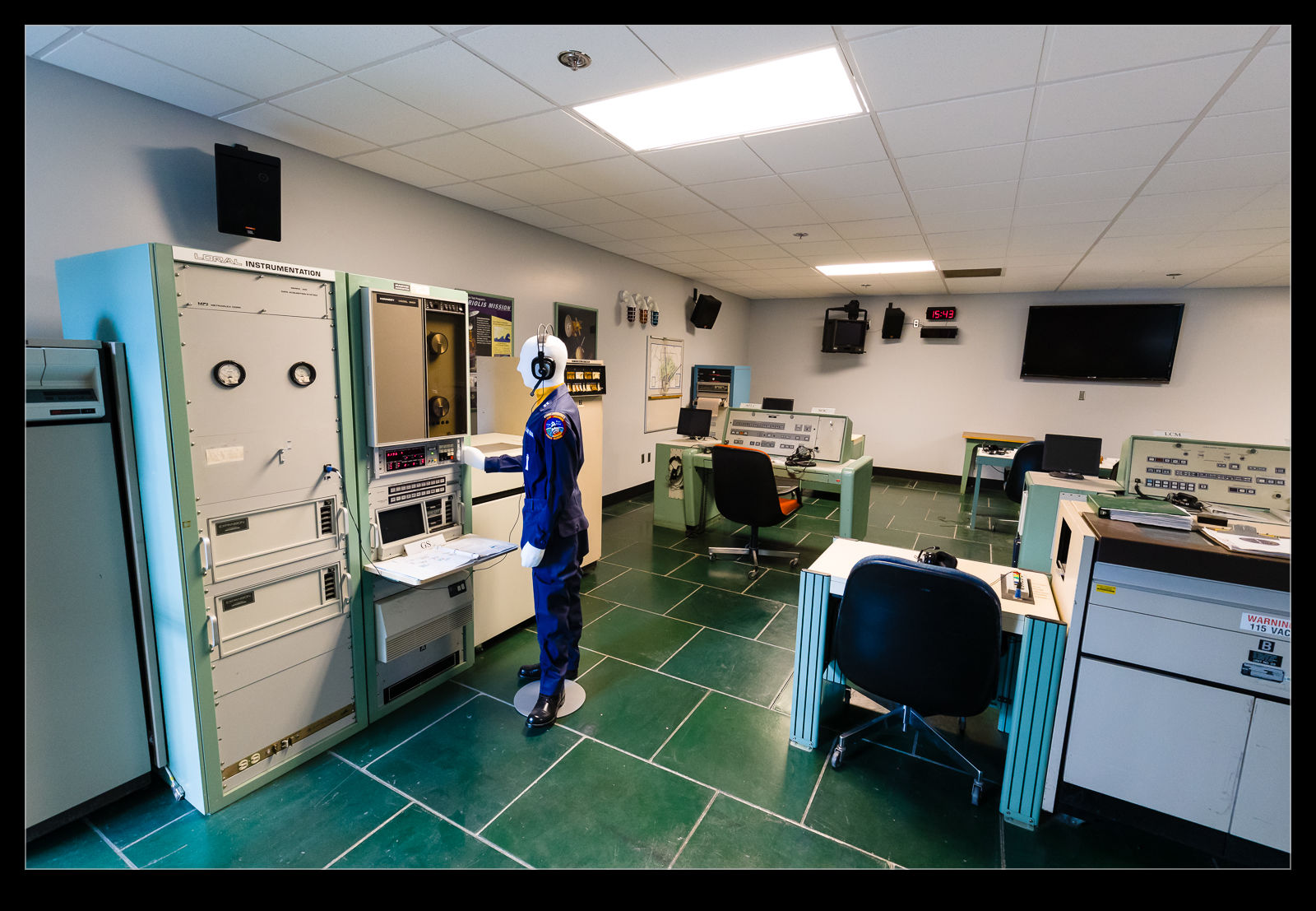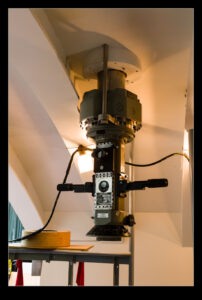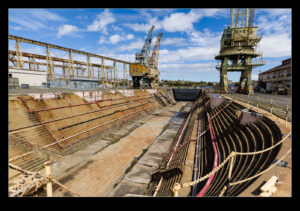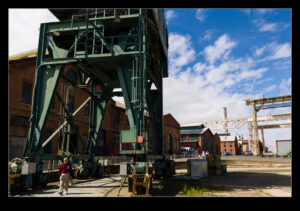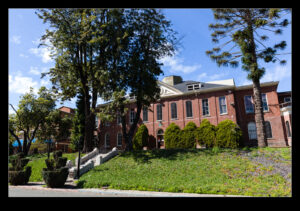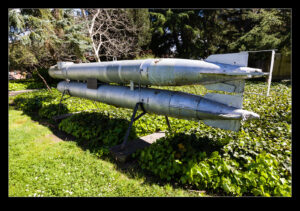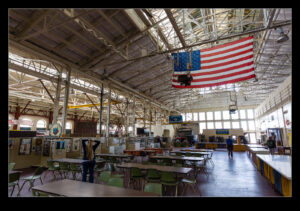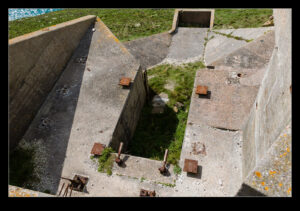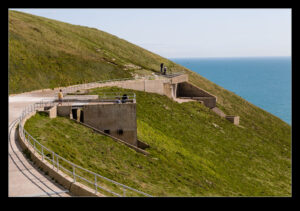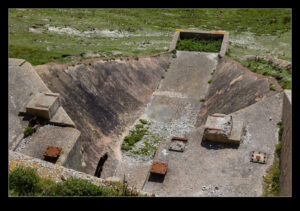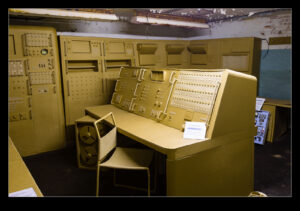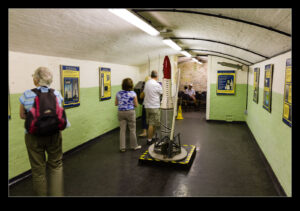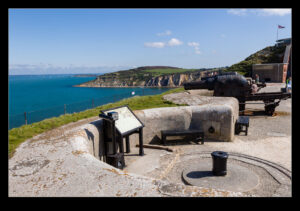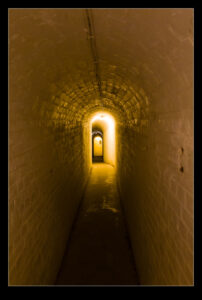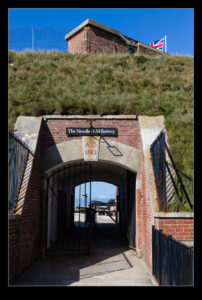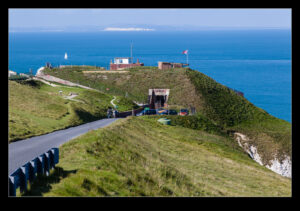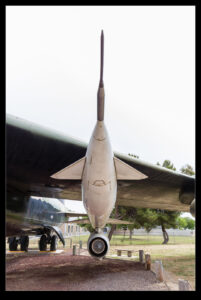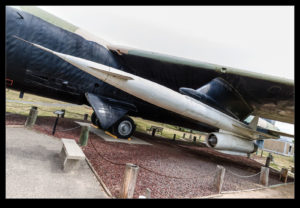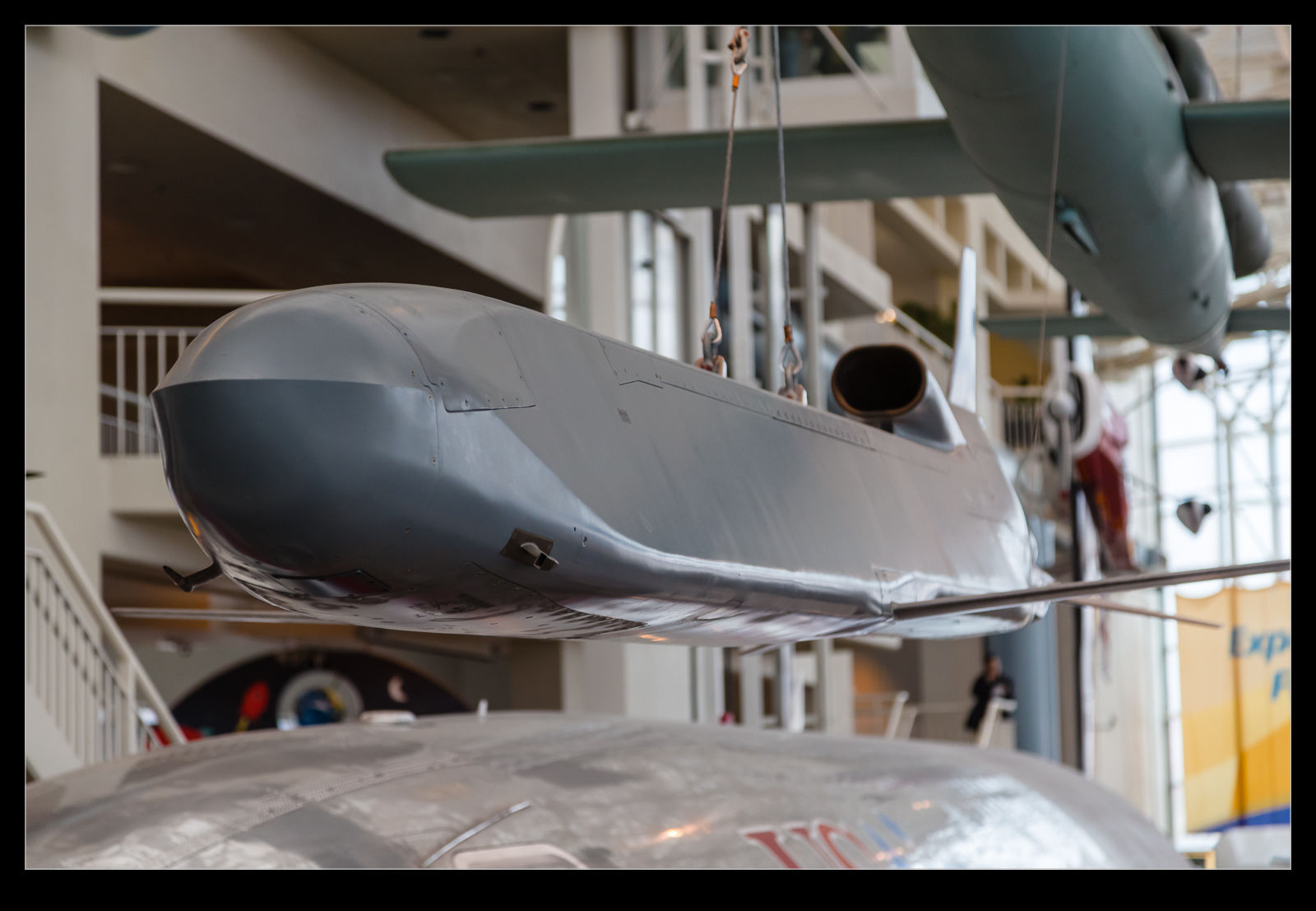 The Museum of Flight seems to have two examples of the air launched cruise missile. This is the Boeing developed AGM-86 missile. One of them is hanging from the roof in the main museum complex while the other is in the restoration facility up at Paine Field. I don’t know which versions of the missile they are. Some were nuclear armed (this version remains in service I believe) while others had a conventional warhead (and I read that these were retired recently). The missiles were widely deployed on B-52s and B-1Bs but I understand that only one wing of the B-52 now has them.
The Museum of Flight seems to have two examples of the air launched cruise missile. This is the Boeing developed AGM-86 missile. One of them is hanging from the roof in the main museum complex while the other is in the restoration facility up at Paine Field. I don’t know which versions of the missile they are. Some were nuclear armed (this version remains in service I believe) while others had a conventional warhead (and I read that these were retired recently). The missiles were widely deployed on B-52s and B-1Bs but I understand that only one wing of the B-52 now has them.
Tag Archives: missile
Titan II Installation
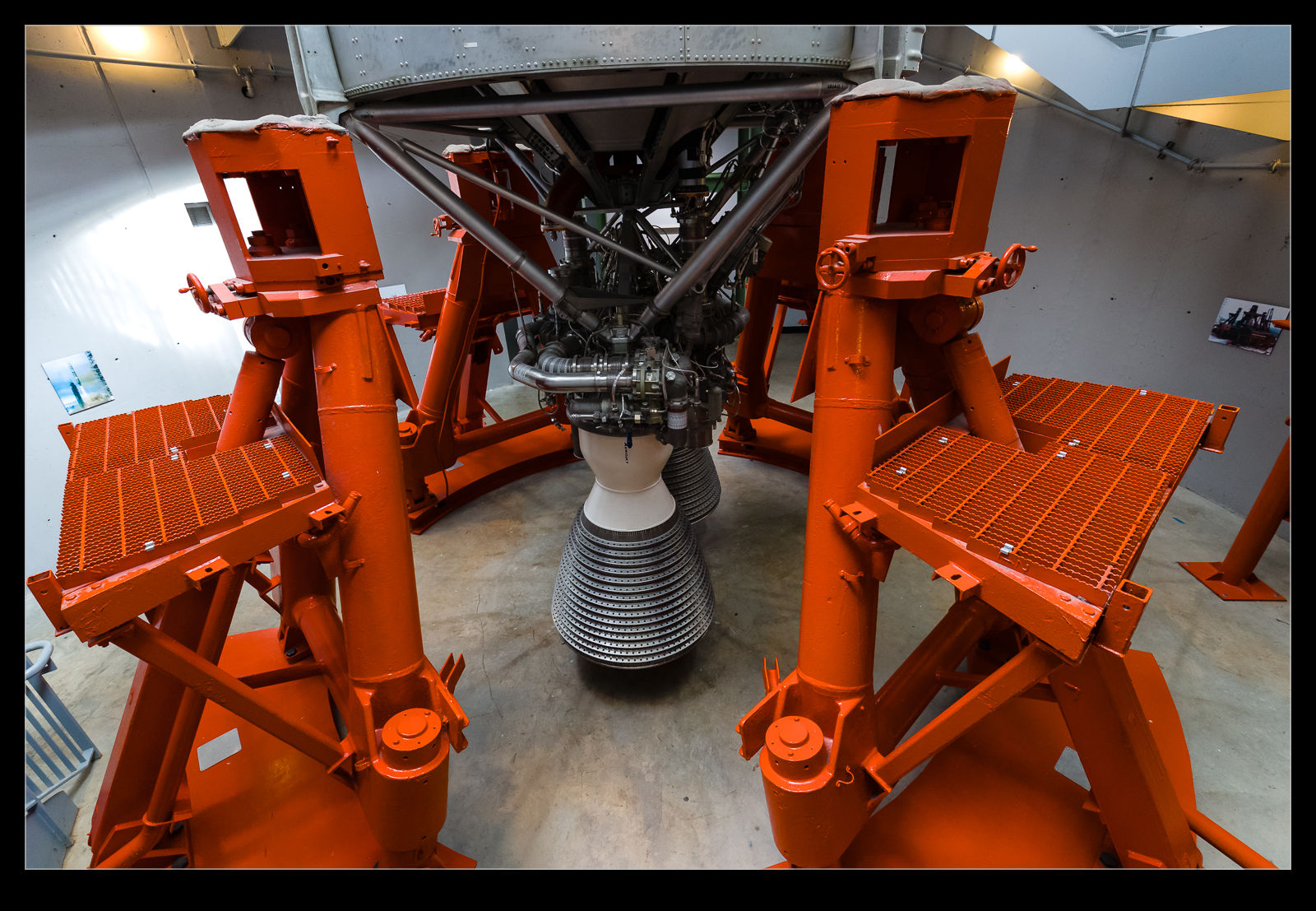 The Titan IV at Evergreen isn’t the only Titan there. They also have a Titan II ICBM. This is installed upright in a recreation of the launch facility that would originally have been buried deep under a remote part of the US countryside. You can walk down and check out the control facilities (probably a touch closer to the silo than would originally have been the case) as well as get down to the base of the silo where the twin nozzles of the missile are. Looking up at the missile from down there is quite an impressive sight.
The Titan IV at Evergreen isn’t the only Titan there. They also have a Titan II ICBM. This is installed upright in a recreation of the launch facility that would originally have been buried deep under a remote part of the US countryside. You can walk down and check out the control facilities (probably a touch closer to the silo than would originally have been the case) as well as get down to the base of the silo where the twin nozzles of the missile are. Looking up at the missile from down there is quite an impressive sight.
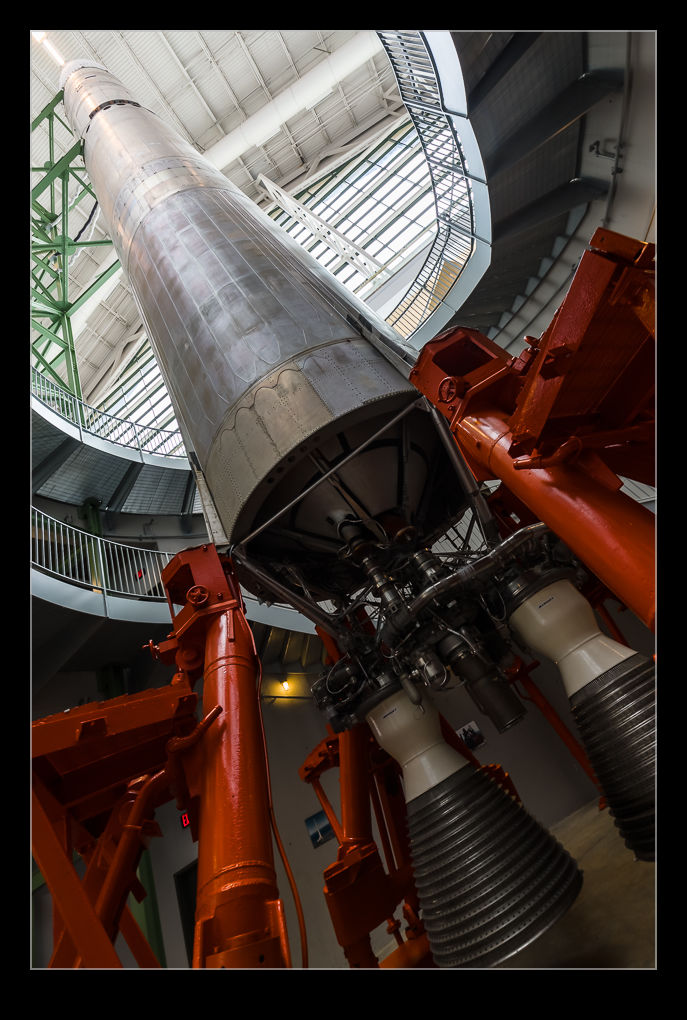 The Titans were liquid fueled rockets. The process of getting them ready for launch was a lot more complex than for the solid fueled rockets like the Minuteman that replaced them so they were a lot less responsive. However, they fulfilled their role for a long time. They also had a secondary career as manned launchers. The Titan II was the launch vehicle for the Gemini missions so it is a lot more familiar to most people than would be the case for the average ICBM!
The Titans were liquid fueled rockets. The process of getting them ready for launch was a lot more complex than for the solid fueled rockets like the Minuteman that replaced them so they were a lot less responsive. However, they fulfilled their role for a long time. They also had a secondary career as manned launchers. The Titan II was the launch vehicle for the Gemini missions so it is a lot more familiar to most people than would be the case for the average ICBM!
Nozzle Details on Titan IV
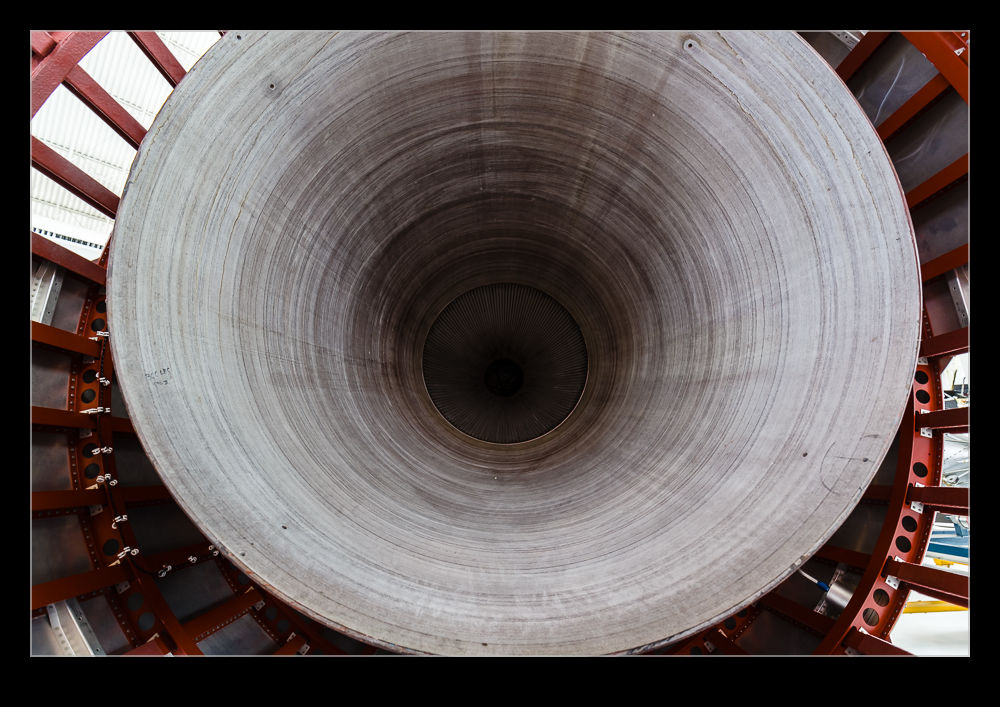 The missile display at Evergreen Aerospace Museum is impressive. They have sourced a lot of different types and they have a Titan IV section lying on its side. You can get up close to the nozzle of the rocket motor and it is a cool thing to see in detail. Looking from a distance, they look very simple but, once you are close up, the complexity of the structure and the cooling structure to stop the plume from burning right through the nozzle are really impressive. The shaping of the nozzle itself, in contrast, is very simple. The expansion ratios are calculated carefully and the profile is a smooth transition to minimize the losses. Quite the contrast.
The missile display at Evergreen Aerospace Museum is impressive. They have sourced a lot of different types and they have a Titan IV section lying on its side. You can get up close to the nozzle of the rocket motor and it is a cool thing to see in detail. Looking from a distance, they look very simple but, once you are close up, the complexity of the structure and the cooling structure to stop the plume from burning right through the nozzle are really impressive. The shaping of the nozzle itself, in contrast, is very simple. The expansion ratios are calculated carefully and the profile is a smooth transition to minimize the losses. Quite the contrast.
Missile Load Training
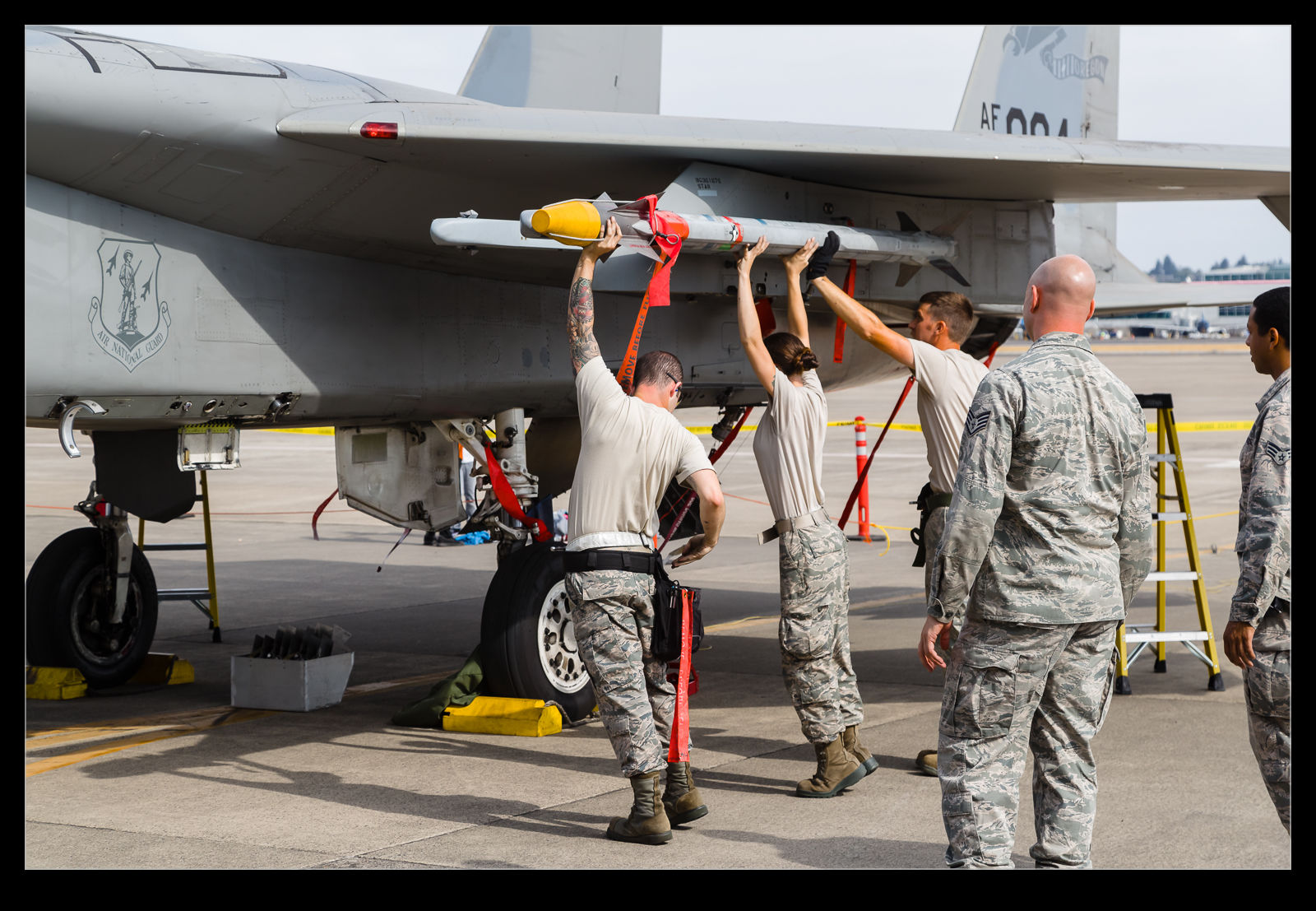 The open day at the Portland ANG base included a demonstration of missile loading. A jet had been parked out on the ramp for the morning and there was a rack of missiles also on display. Towards the end of the morning, a team started to prep the jet for loading. This was an exercise that had multiple purposes. It was a demonstration for the guests, but it was also a qualification test.
The open day at the Portland ANG base included a demonstration of missile loading. A jet had been parked out on the ramp for the morning and there was a rack of missiles also on display. Towards the end of the morning, a team started to prep the jet for loading. This was an exercise that had multiple purposes. It was a demonstration for the guests, but it was also a qualification test.
 Apparently, the crews are required to carry out a loading drill every 90 days when they are timed and observed in order to maintain their qualifications. Therefore, a pair of observers were there to watch the three-person team do their work. It can’t have been fun to have the public watching and the assessment team overseeing you at the same time. The crew got to it though and they seemed to be diligently following every procedure which is no bad thing when you are potentially dealing with live weapons (not that these examples were in any way live).
Apparently, the crews are required to carry out a loading drill every 90 days when they are timed and observed in order to maintain their qualifications. Therefore, a pair of observers were there to watch the three-person team do their work. It can’t have been fun to have the public watching and the assessment team overseeing you at the same time. The crew got to it though and they seemed to be diligently following every procedure which is no bad thing when you are potentially dealing with live weapons (not that these examples were in any way live).
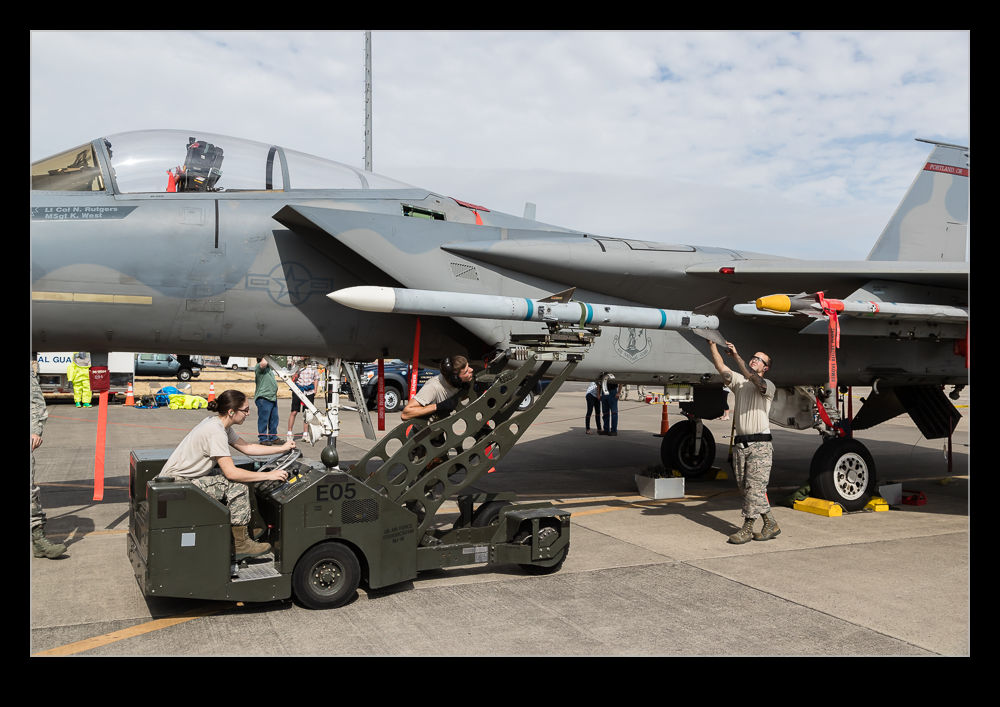 The missile configuration was quite a mix. They had six AMRAAMS to load, four on the fuselage and two on the stub pylons. The other two stubs were fitted with an AIM-9M and an AIM-9X. The Sidewinders were loaded by hand but the AMRAAMs are heavier and required the use of a mechanical loader. Prepping the plane before the missiles came close took a while and then the missiles were loaded in sequence with things like fins being added at different times such that some were on before the missile was attached and some were added once it was installed.
The missile configuration was quite a mix. They had six AMRAAMS to load, four on the fuselage and two on the stub pylons. The other two stubs were fitted with an AIM-9M and an AIM-9X. The Sidewinders were loaded by hand but the AMRAAMs are heavier and required the use of a mechanical loader. Prepping the plane before the missiles came close took a while and then the missiles were loaded in sequence with things like fins being added at different times such that some were on before the missile was attached and some were added once it was installed.
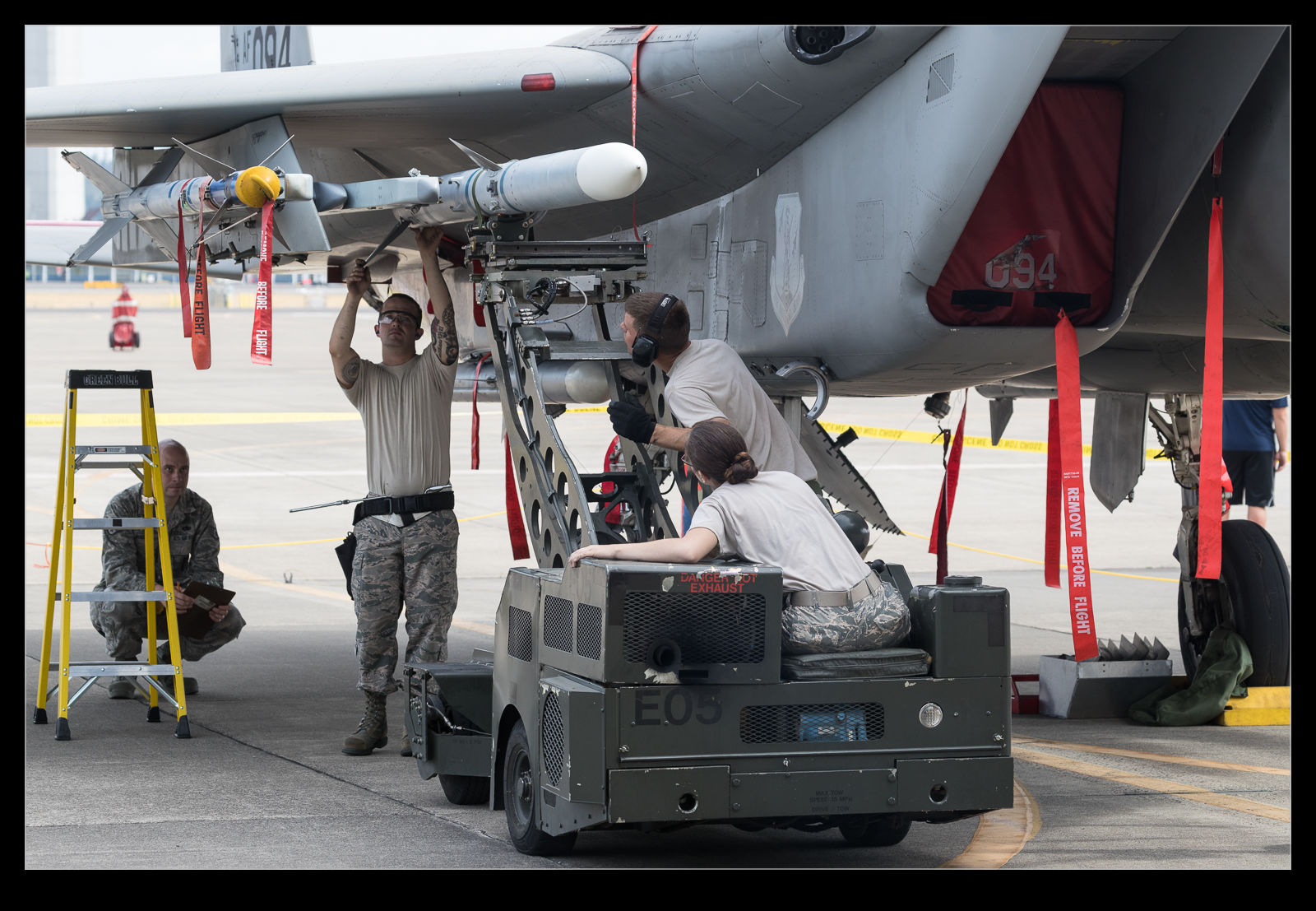 Once the whole task was completed, they reversed the process and removed the missiles. There was some choreography involved with getting the loader in place. It is not a subtle piece of machinery, but it could be placed quite accurately. Then there is adjustability in the rotation and position of the missile holders to allow things to be fine-tuned into position. Maneuvering a missile on to the rail or the launcher while not hitting anything else also requires some careful work. It was a most interesting process to watch.
Once the whole task was completed, they reversed the process and removed the missiles. There was some choreography involved with getting the loader in place. It is not a subtle piece of machinery, but it could be placed quite accurately. Then there is adjustability in the rotation and position of the missile holders to allow things to be fine-tuned into position. Maneuvering a missile on to the rail or the launcher while not hitting anything else also requires some careful work. It was a most interesting process to watch.
Mare Island Museum
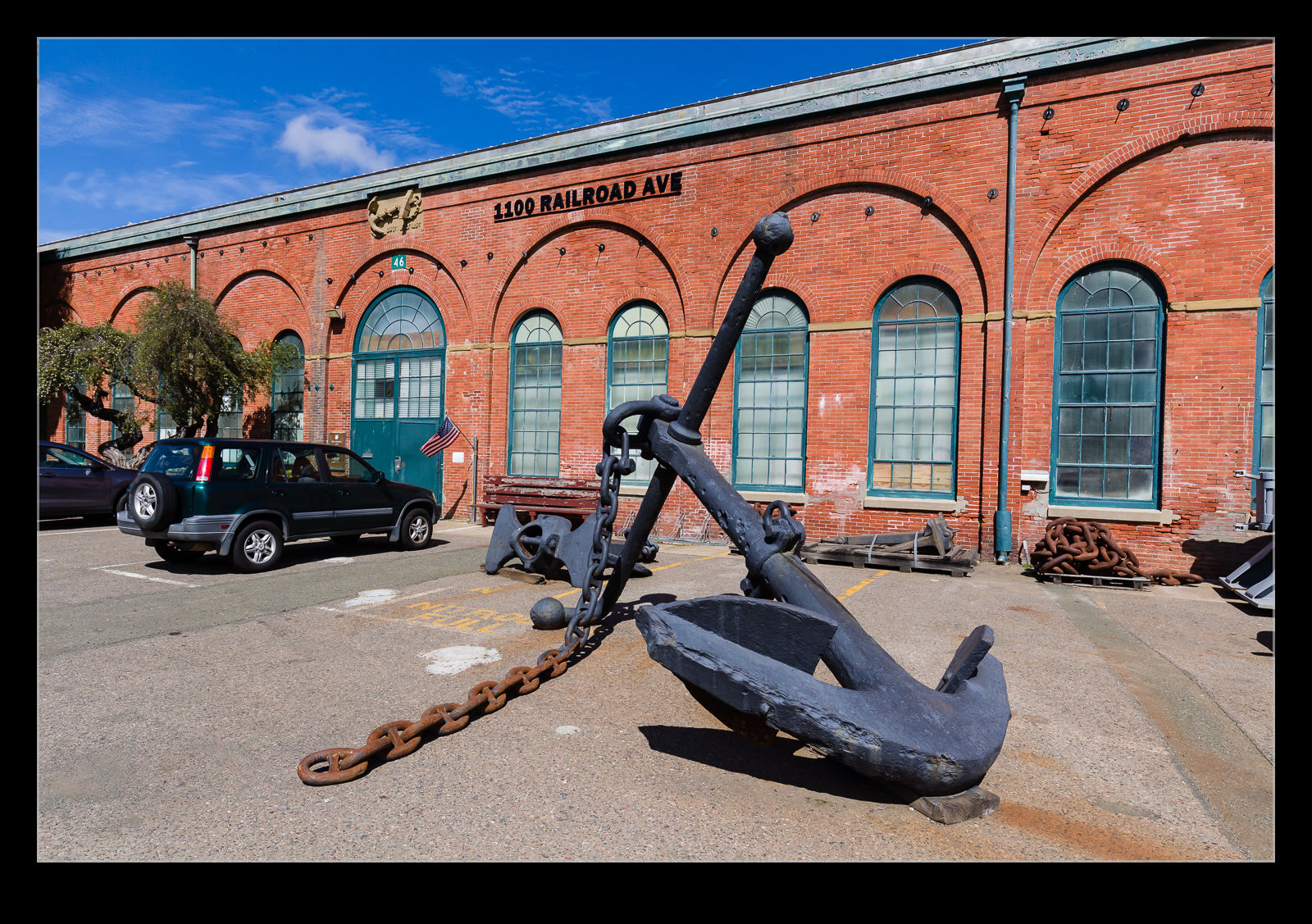 The Society of Aviation History organized a visit to Mare Island recently and I went along. The tour started at the museum and walked to a number of locations before ending up back at the museum which we were then free to roam around. I will start at the end today and cover a little about the museum itself. That should set the scene for the follow up posts about elements of Mare Island that we took a look at.
The Society of Aviation History organized a visit to Mare Island recently and I went along. The tour started at the museum and walked to a number of locations before ending up back at the museum which we were then free to roam around. I will start at the end today and cover a little about the museum itself. That should set the scene for the follow up posts about elements of Mare Island that we took a look at.
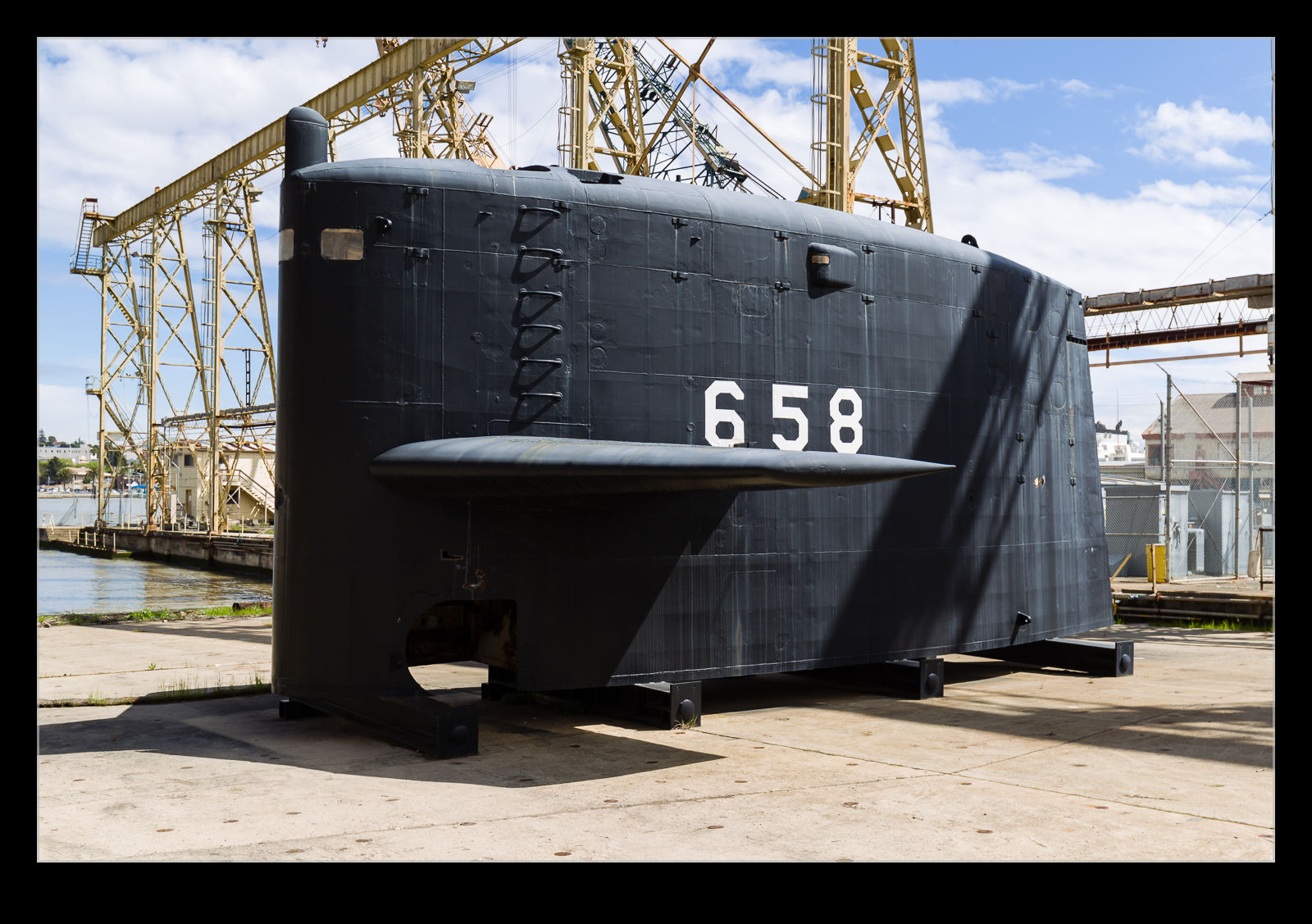 Mare Island was a naval shipyard. From its earliest days it grew into a major shipbuilding facility. In its later days, it was involved in building many nuclear submarines. Ultimately, as part of the reduction in bases undertaken in various phases around the US and beyond, Mare Island was closed as a naval facility and returned to the local community. Much ship related work is still undertaken but the location is a faction of what it once was.
Mare Island was a naval shipyard. From its earliest days it grew into a major shipbuilding facility. In its later days, it was involved in building many nuclear submarines. Ultimately, as part of the reduction in bases undertaken in various phases around the US and beyond, Mare Island was closed as a naval facility and returned to the local community. Much ship related work is still undertaken but the location is a faction of what it once was.
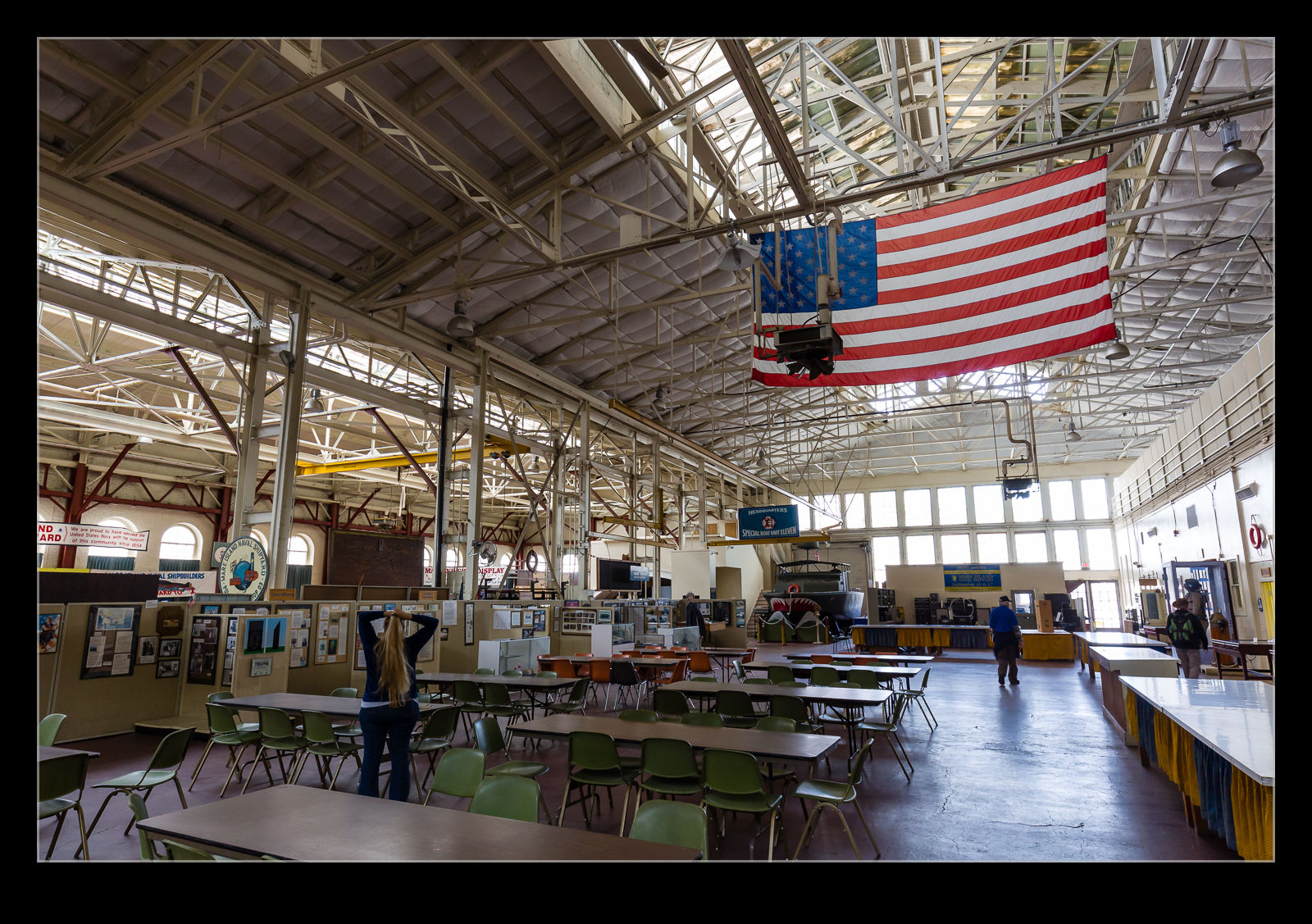 The museum has a lot of displays of what went on at various stages in the history of the yard. Outside there are some missiles and cannons on display covering old wooden frigates through to a Polaris missile from a nuclear ballistic missile boat. The submarine theme shows up in many of the displays and a periscope has been recovered from a submarine and erected in the museum. You can operate it and survey the surrounding area. The clarity of the optics is quite amazing.
The museum has a lot of displays of what went on at various stages in the history of the yard. Outside there are some missiles and cannons on display covering old wooden frigates through to a Polaris missile from a nuclear ballistic missile boat. The submarine theme shows up in many of the displays and a periscope has been recovered from a submarine and erected in the museum. You can operate it and survey the surrounding area. The clarity of the optics is quite amazing.
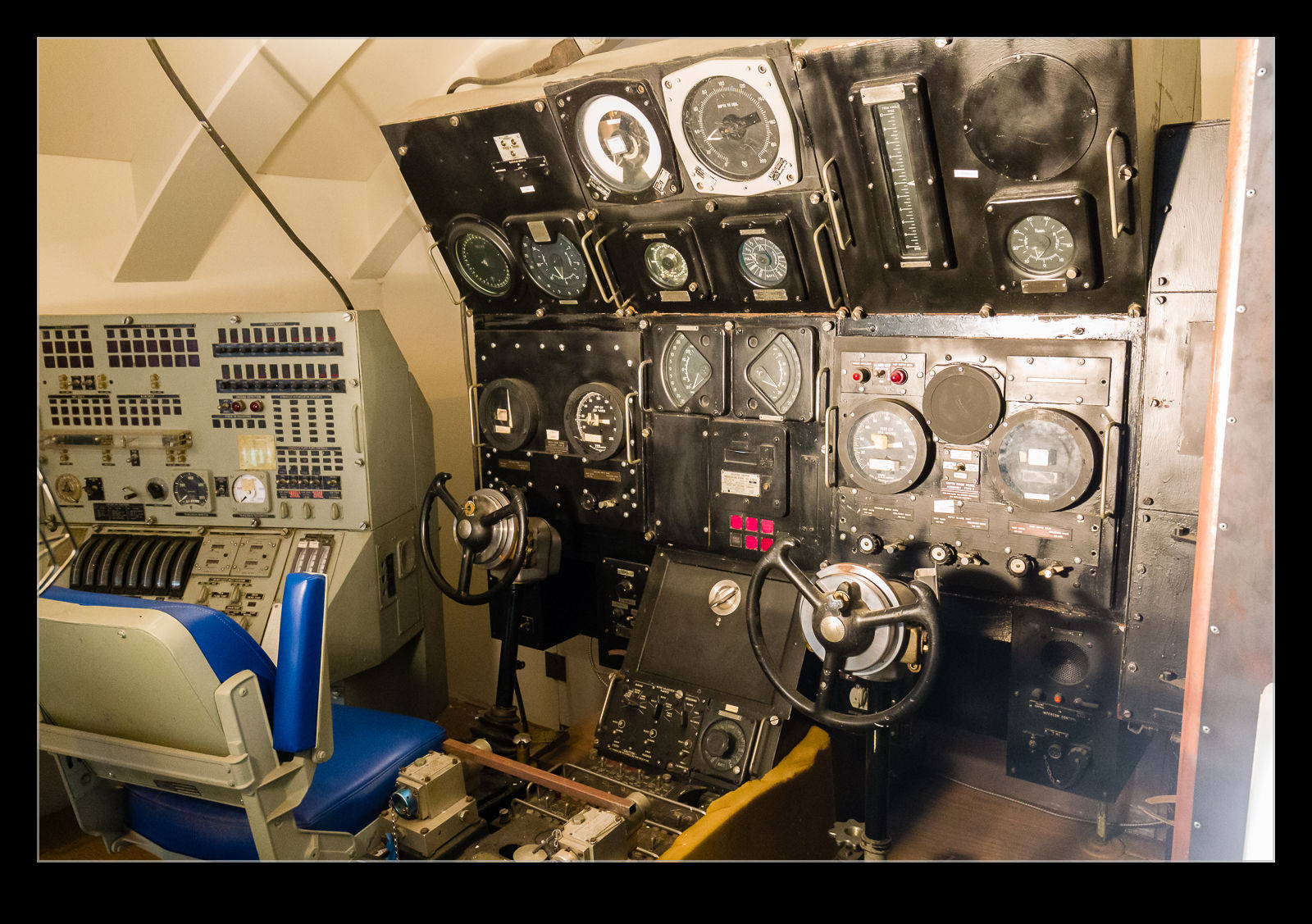 The running of the museum is not cheap – not least because the local town of Vallejo charges them a substantial tax each month. Therefore, getting people to visit is an important issue for them. If you have a free day, I would certainly pay them a visit and see a little of the shipbuilding history of the area.
The running of the museum is not cheap – not least because the local town of Vallejo charges them a substantial tax each month. Therefore, getting people to visit is an important issue for them. If you have a free day, I would certainly pay them a visit and see a little of the shipbuilding history of the area.
ASRAAM Self Portrait
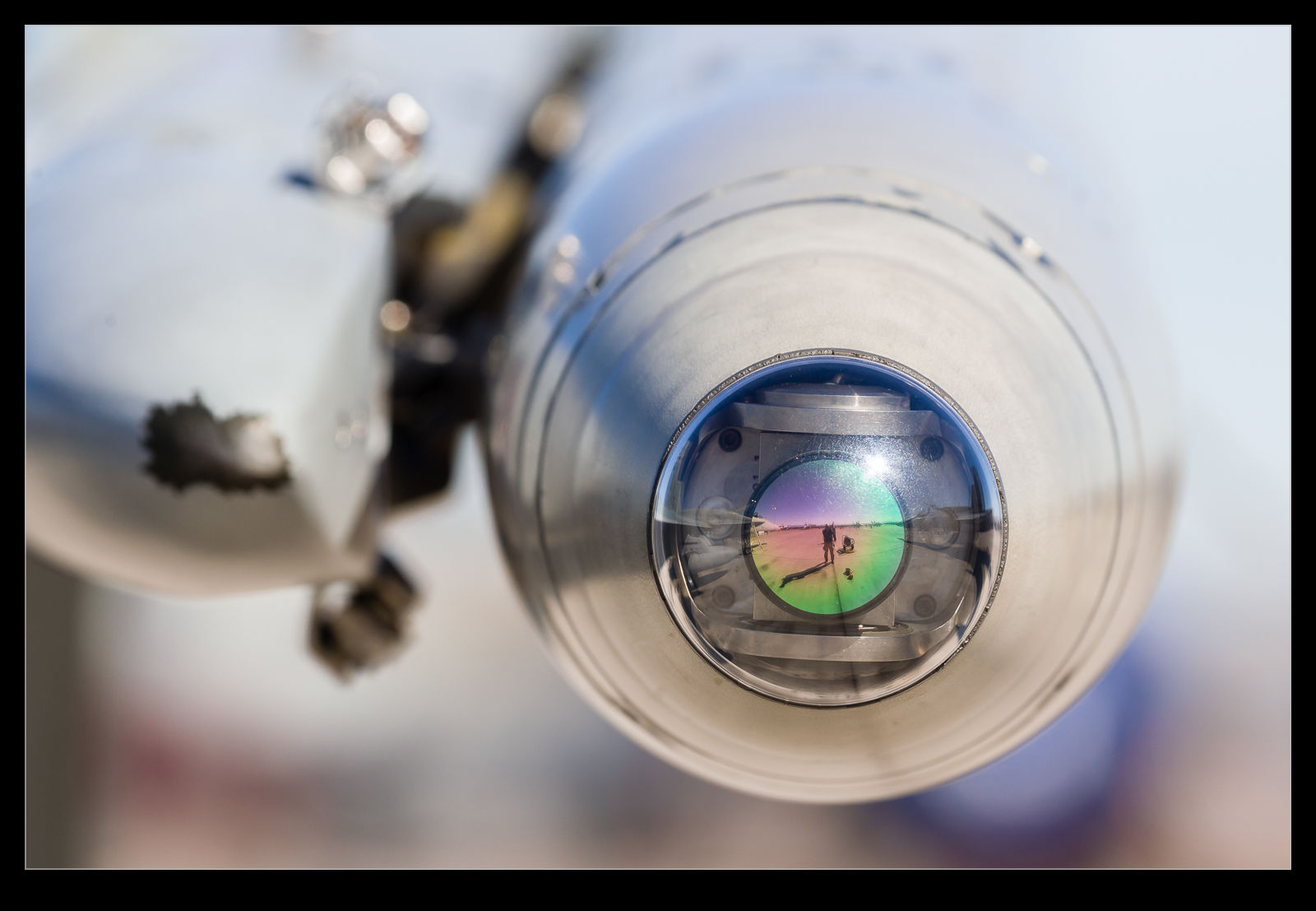 While waking along the ramp occupied by the RAAF Hornets, one of the ASRAAM missiles on the wingtip launch rail of an A-model Hornet had its seeker cover removed. It was dangling by a strap and I was going to ask one of the ground crew if we should replace it. Then I got distracted by the seeker itself. It looked pretty cool and was reflecting light in an interesting way. Naturally, when you are near something reflective, the idea of a self-portrait jumps to mind if you are a little self-obsessed so I couldn’t help myself. Many years ago I worked on an ASRAAM seeker development related task using the company Jetstream testbed so I can pretend all of this is a technical interest and not narcissism at all.
While waking along the ramp occupied by the RAAF Hornets, one of the ASRAAM missiles on the wingtip launch rail of an A-model Hornet had its seeker cover removed. It was dangling by a strap and I was going to ask one of the ground crew if we should replace it. Then I got distracted by the seeker itself. It looked pretty cool and was reflecting light in an interesting way. Naturally, when you are near something reflective, the idea of a self-portrait jumps to mind if you are a little self-obsessed so I couldn’t help myself. Many years ago I worked on an ASRAAM seeker development related task using the company Jetstream testbed so I can pretend all of this is a technical interest and not narcissism at all.
Needles Battery
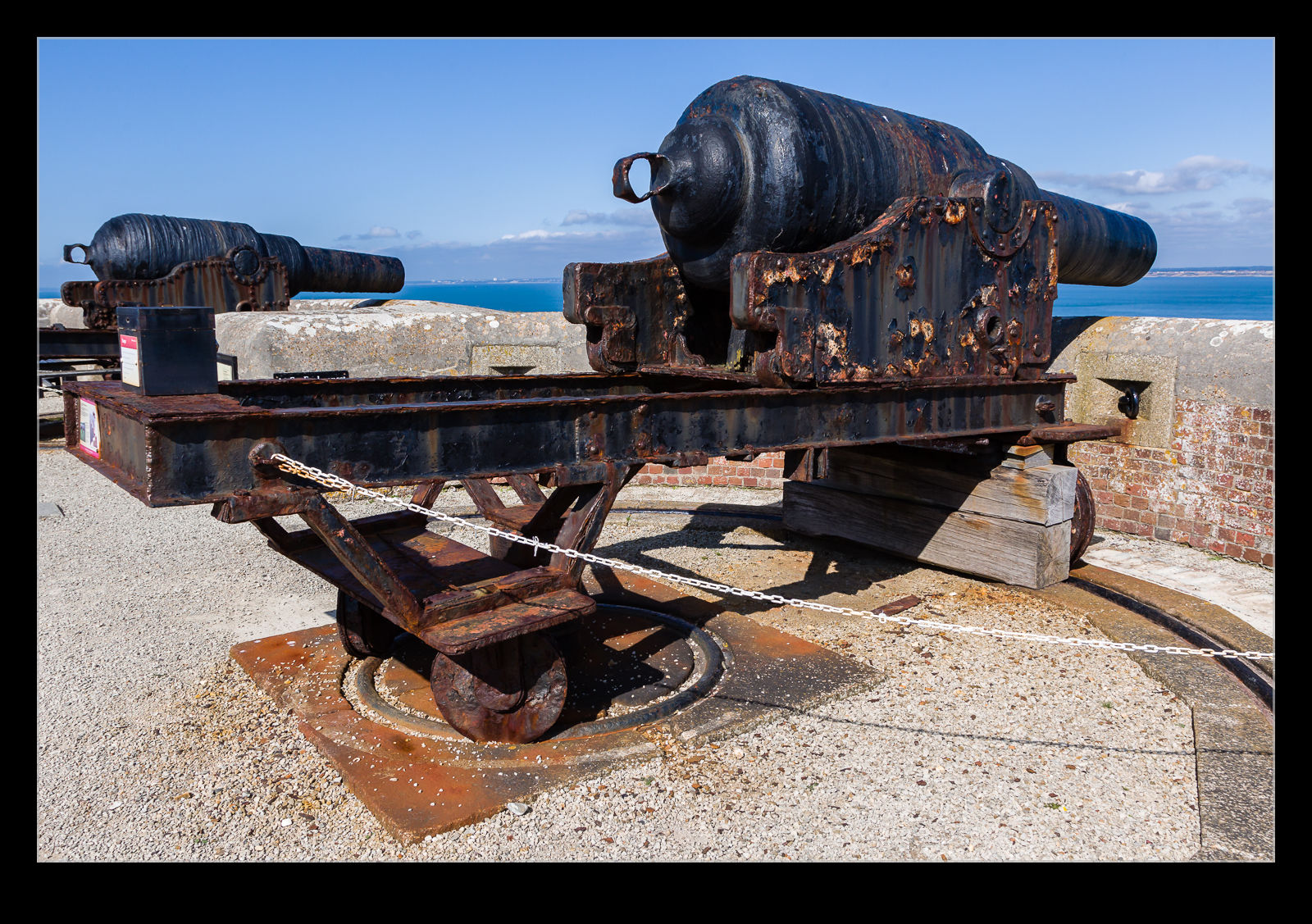 I posted some shots of the Needles in this post. The rocky outcrops are not the only thing of interest, however. The strategic location of the cliffs and the importance of some of the military facilities in the waters approached via the Needles mean a fort was constructed overlooking the entry to the Solent during the Victorian era. Large guns were mounted on the top of the cliffs to deal with any enemy that might come.
I posted some shots of the Needles in this post. The rocky outcrops are not the only thing of interest, however. The strategic location of the cliffs and the importance of some of the military facilities in the waters approached via the Needles mean a fort was constructed overlooking the entry to the Solent during the Victorian era. Large guns were mounted on the top of the cliffs to deal with any enemy that might come.
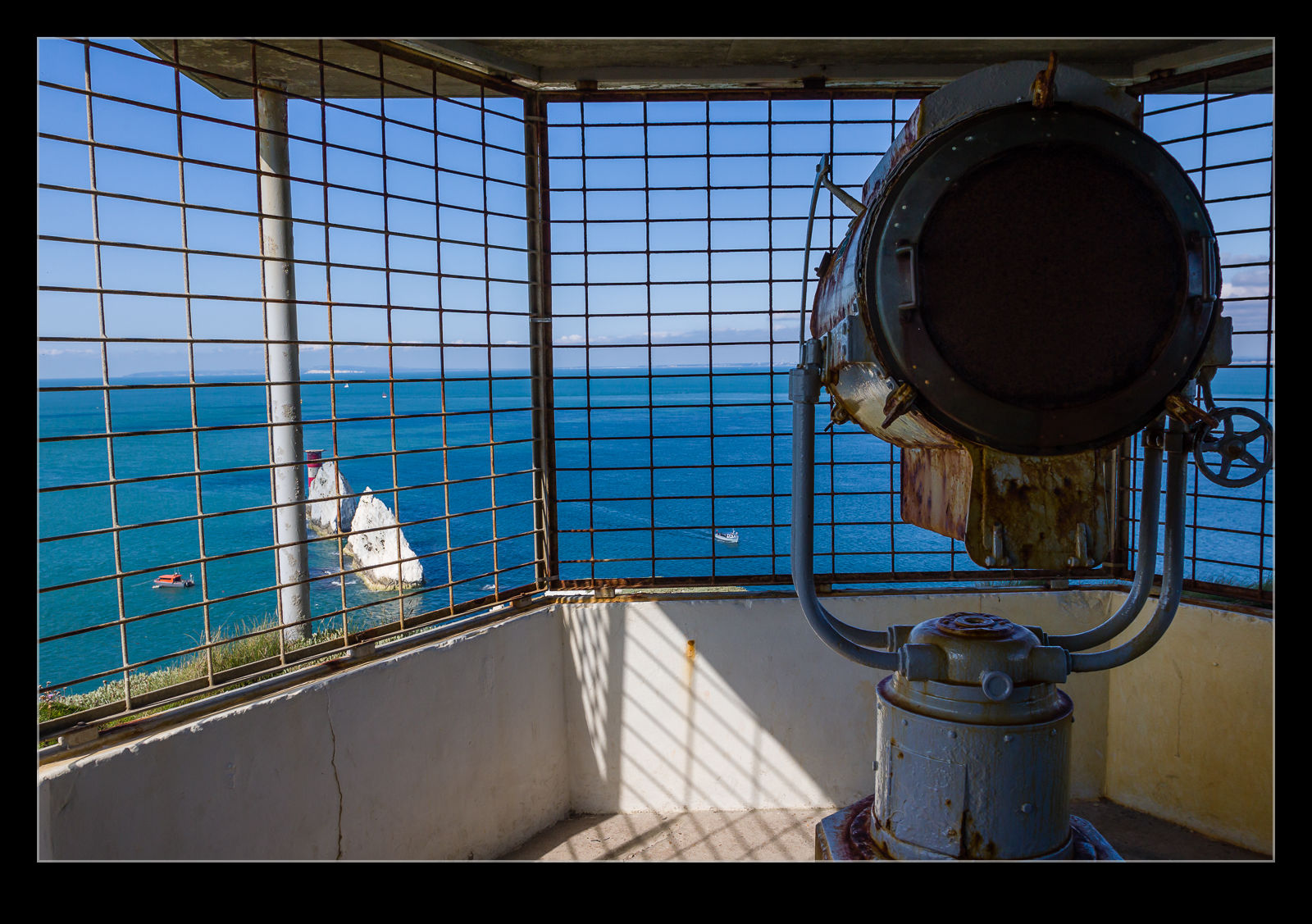 In the end, no enemy came. However, when the First World War came, there was again a need to protect the approaches. The existing location was not suitable for the size of guns then in use so a new battery was built a little higher up on the cliffs. As with the first one, it stood guard but never engaged any enemy.
In the end, no enemy came. However, when the First World War came, there was again a need to protect the approaches. The existing location was not suitable for the size of guns then in use so a new battery was built a little higher up on the cliffs. As with the first one, it stood guard but never engaged any enemy.
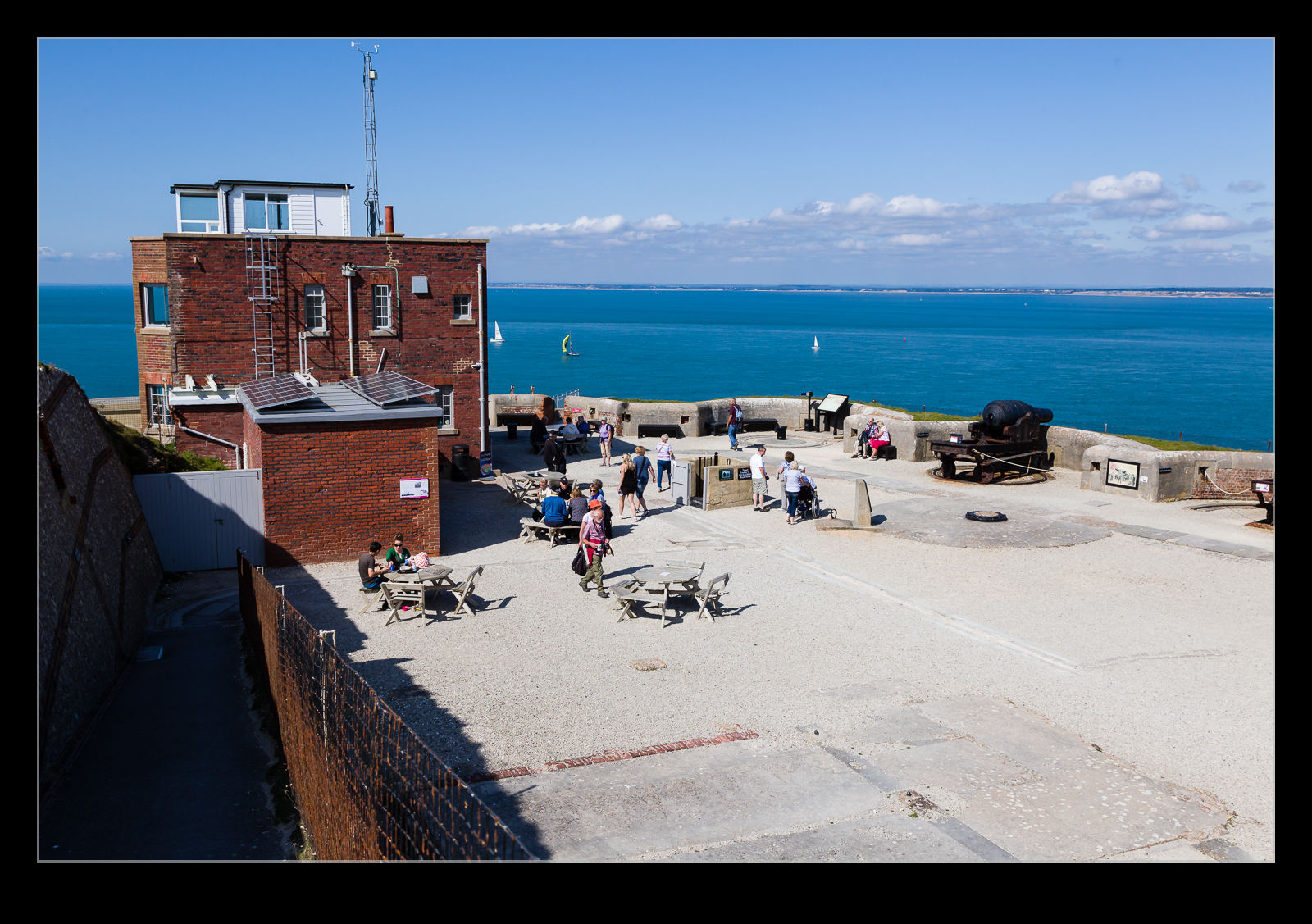 In the middle of the 20th century, the location again found a use. Britain had a space launcher development program with the rockets being developed at Saunders Roe in nearby East Cowes. The location on the cliff tops, a long way from most population areas, with nothing but sea below and no overlooking locations for prying eyes meant it was an ideal location for secret programs. A couple of test stands were built for the rockets to be mounted for testing purposes.
In the middle of the 20th century, the location again found a use. Britain had a space launcher development program with the rockets being developed at Saunders Roe in nearby East Cowes. The location on the cliff tops, a long way from most population areas, with nothing but sea below and no overlooking locations for prying eyes meant it was an ideal location for secret programs. A couple of test stands were built for the rockets to be mounted for testing purposes.
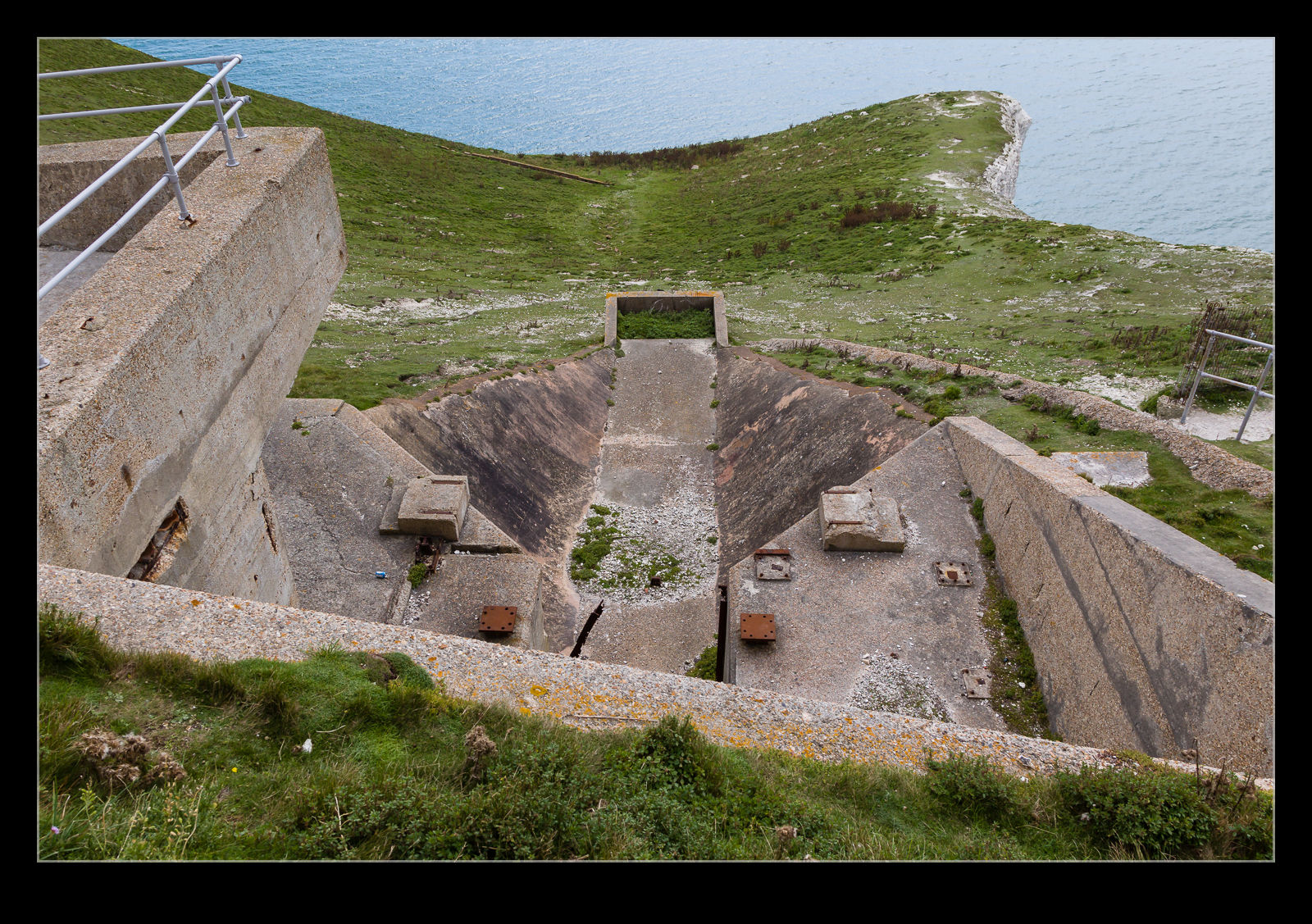 Now everything is decommissioned and is open for the public to view. The location on top of the cliffs is very cool anyway but, if you are an engineer type like me, the test facilities are even better. The bunkers and control rooms are worth a look and one of them even has the equipment recreated in cardboard. That might sound strange but it has been done well and even includes a cardboard coat hanging up on the wall. It is a very innovative approach to reproducing what had been taken apart long ago.
Now everything is decommissioned and is open for the public to view. The location on top of the cliffs is very cool anyway but, if you are an engineer type like me, the test facilities are even better. The bunkers and control rooms are worth a look and one of them even has the equipment recreated in cardboard. That might sound strange but it has been done well and even includes a cardboard coat hanging up on the wall. It is a very innovative approach to reproducing what had been taken apart long ago.
Hound Dog
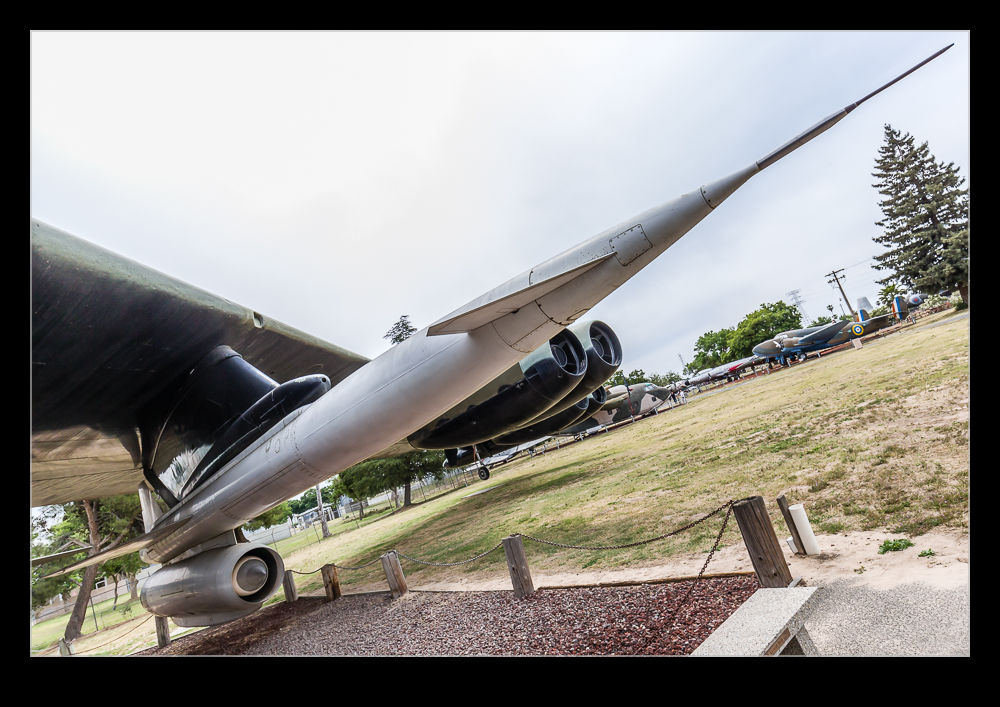 Sometimes you see something that just looks the right way. Tucked under the wing of the B-52 at Castle Air Museum is a Hound Dog missile. This was a nuclear armed stand off weapon carried by the B-52s for a number of years. It is a slim airframe with a jet mounted underneath. It is all points and sweep back. If anything looks like it should go fast, this thing is it. I have no idea whether it was a good design or effective. It was never required in anger thankfully. All I know is that you are left in no doubt what it is supposed to do!
Sometimes you see something that just looks the right way. Tucked under the wing of the B-52 at Castle Air Museum is a Hound Dog missile. This was a nuclear armed stand off weapon carried by the B-52s for a number of years. It is a slim airframe with a jet mounted underneath. It is all points and sweep back. If anything looks like it should go fast, this thing is it. I have no idea whether it was a good design or effective. It was never required in anger thankfully. All I know is that you are left in no doubt what it is supposed to do!
Nike Missile Battery
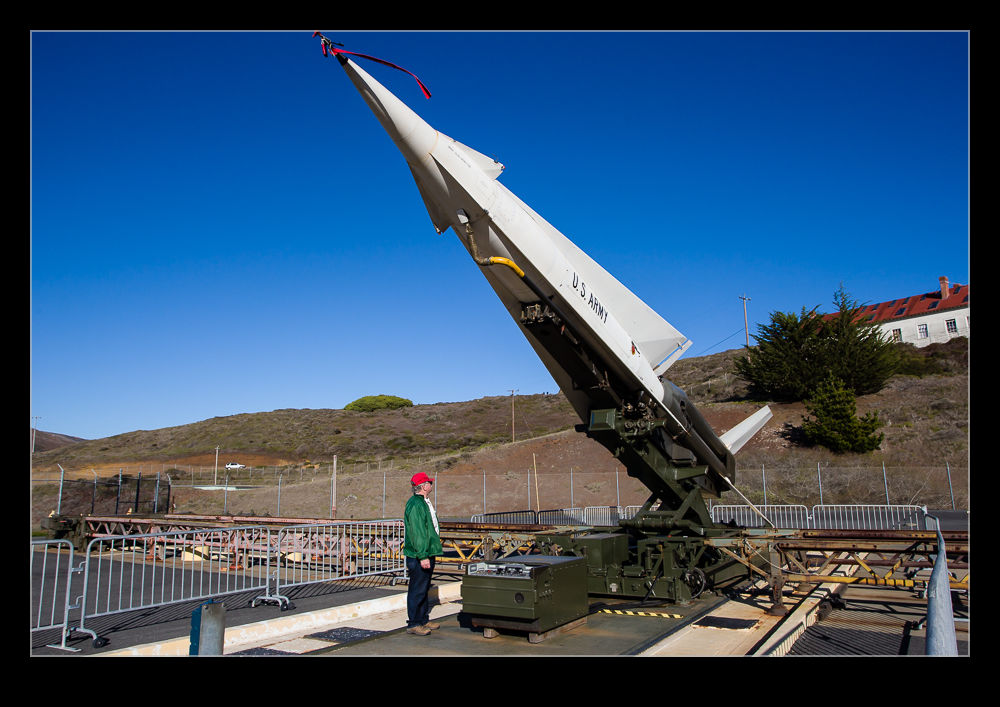 At the height of the cold war, the possibility of large waves of Soviet bombers attacking the United States was considered high. Defending the major cities and defense installations was a high priority. The result was one of (if not the) most expensive defense programs ever. The Nike missile program was an air defense system developed by the US Army. Intended to replace the anti-aircraft gun batteries that were considered incapable of defending against jet aircraft, the goal of Nike was to take out incoming aircraft before they were able to drop thermonuclear weapons on the US. Since the range at which nuclear weapons could cause devastation was high, interception far away from the target was the goal.
At the height of the cold war, the possibility of large waves of Soviet bombers attacking the United States was considered high. Defending the major cities and defense installations was a high priority. The result was one of (if not the) most expensive defense programs ever. The Nike missile program was an air defense system developed by the US Army. Intended to replace the anti-aircraft gun batteries that were considered incapable of defending against jet aircraft, the goal of Nike was to take out incoming aircraft before they were able to drop thermonuclear weapons on the US. Since the range at which nuclear weapons could cause devastation was high, interception far away from the target was the goal.
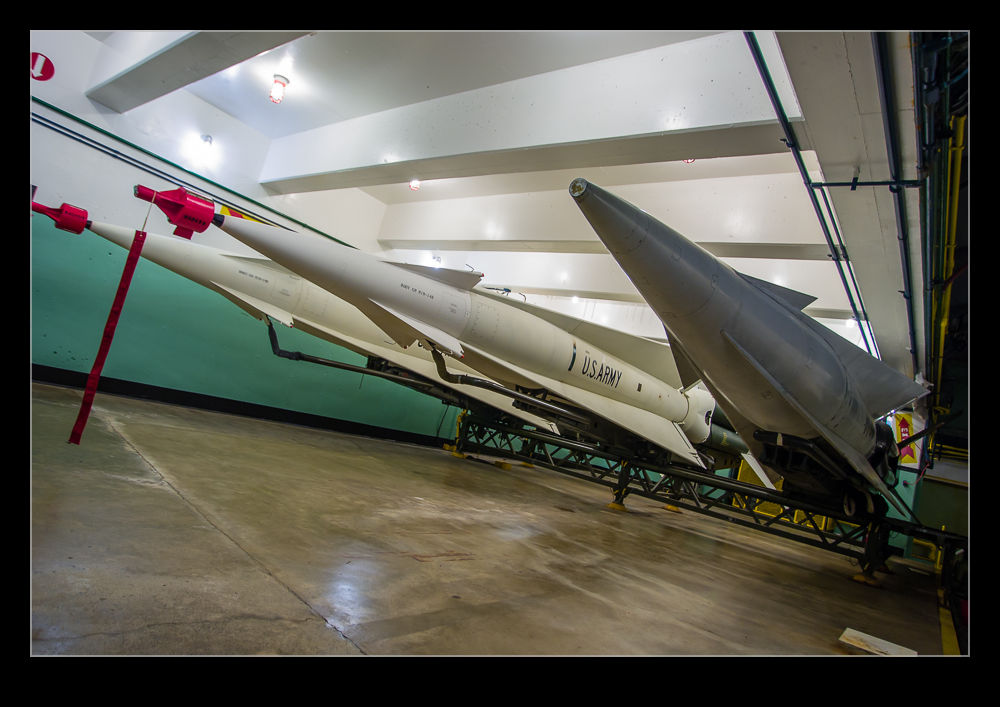 Several different missiles were developed as part of the Nike system. Two if these missiles were the Ajax and the Hercules. Ajax was the first of these two to be developed. It introduced analog computing and tracking of both the target and the missile with the aim of bringing the missile to a successful interception. The range of Ajax was relatively limited and large number of batteries was deployed around the major cities and defense installations.
Several different missiles were developed as part of the Nike system. Two if these missiles were the Ajax and the Hercules. Ajax was the first of these two to be developed. It introduced analog computing and tracking of both the target and the missile with the aim of bringing the missile to a successful interception. The range of Ajax was relatively limited and large number of batteries was deployed around the major cities and defense installations.
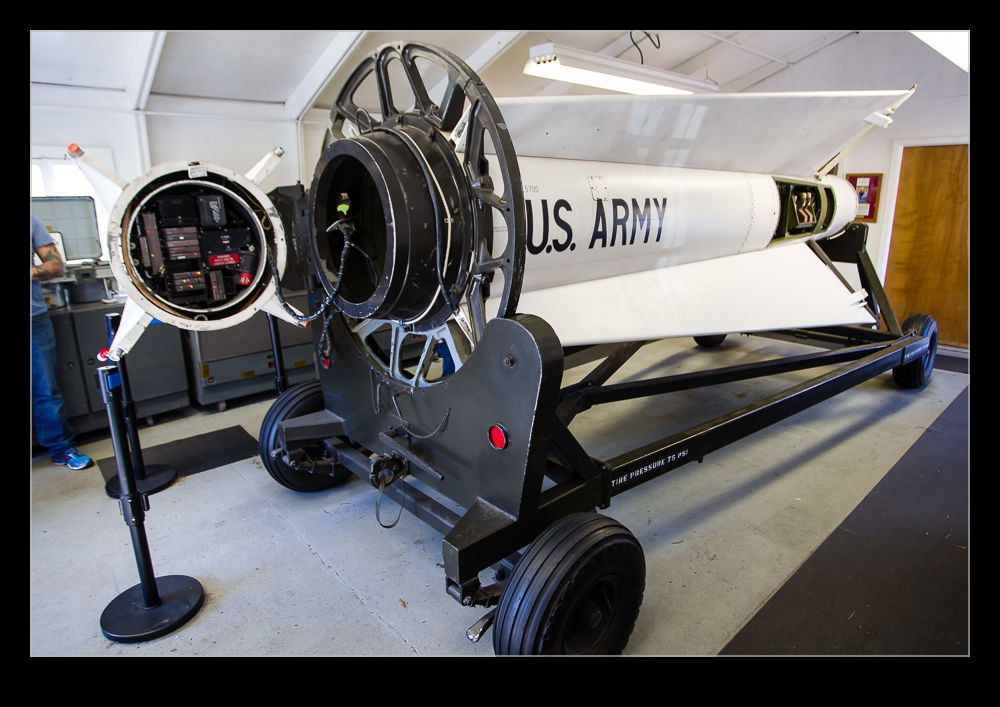 Meanwhile, the Hercules missile was undergoing development. It introduced a far larger booster (actually four of the Ajax boosters strapped together), a larger sustainer motor and new warheads including conventional and nuclear options. The longer range and greater intercept capability of the system meant that fewer batteries were required to achieve coverage and they could be slightly further out from the area being protected. With a range of approximately 100 miles, the Hercules missile could reach its target in approximately 90 seconds. The enormous booster gave it a phenomenal acceleration. By the time the tail of the booster reached the point where the tip of the missile had been on the launcher, the missile was already supersonic.
Meanwhile, the Hercules missile was undergoing development. It introduced a far larger booster (actually four of the Ajax boosters strapped together), a larger sustainer motor and new warheads including conventional and nuclear options. The longer range and greater intercept capability of the system meant that fewer batteries were required to achieve coverage and they could be slightly further out from the area being protected. With a range of approximately 100 miles, the Hercules missile could reach its target in approximately 90 seconds. The enormous booster gave it a phenomenal acceleration. By the time the tail of the booster reached the point where the tip of the missile had been on the launcher, the missile was already supersonic.
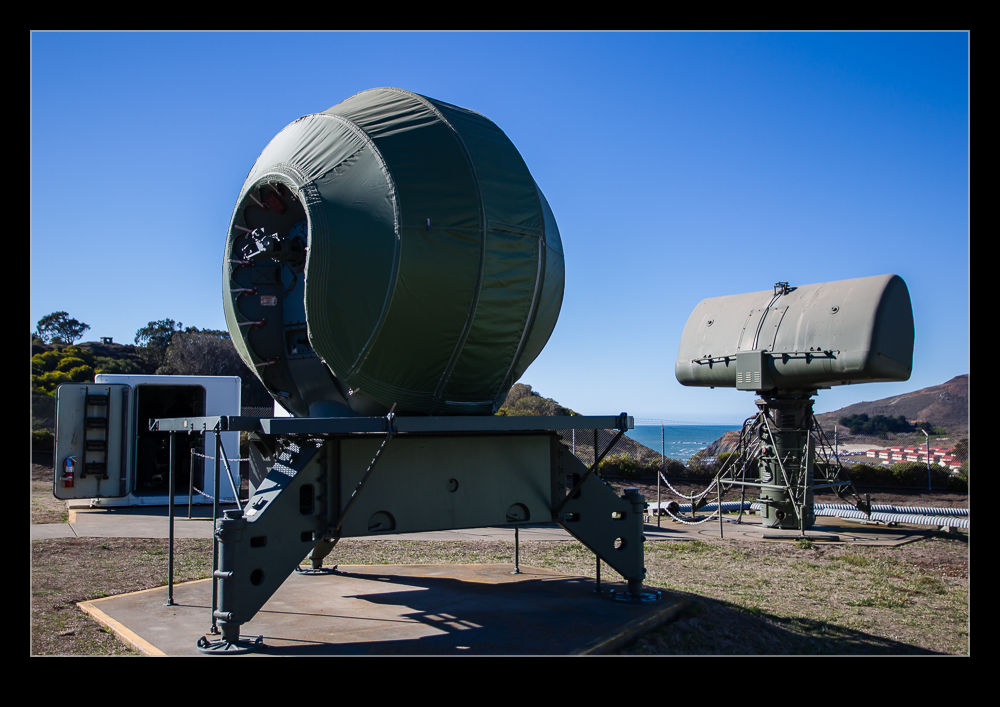 While Hercules had a notional capability against ballistic missiles, the move away from bombers meant the system was more vulnerable a technology advanced. Ultimately, as part of arms limitation treaties, it was decommissioned as part of the anti-ballistic missile systems. While hundreds of installations had once been in service across the United States and other countries, virtually nothing of them now remains.
While Hercules had a notional capability against ballistic missiles, the move away from bombers meant the system was more vulnerable a technology advanced. Ultimately, as part of arms limitation treaties, it was decommissioned as part of the anti-ballistic missile systems. While hundreds of installations had once been in service across the United States and other countries, virtually nothing of them now remains.
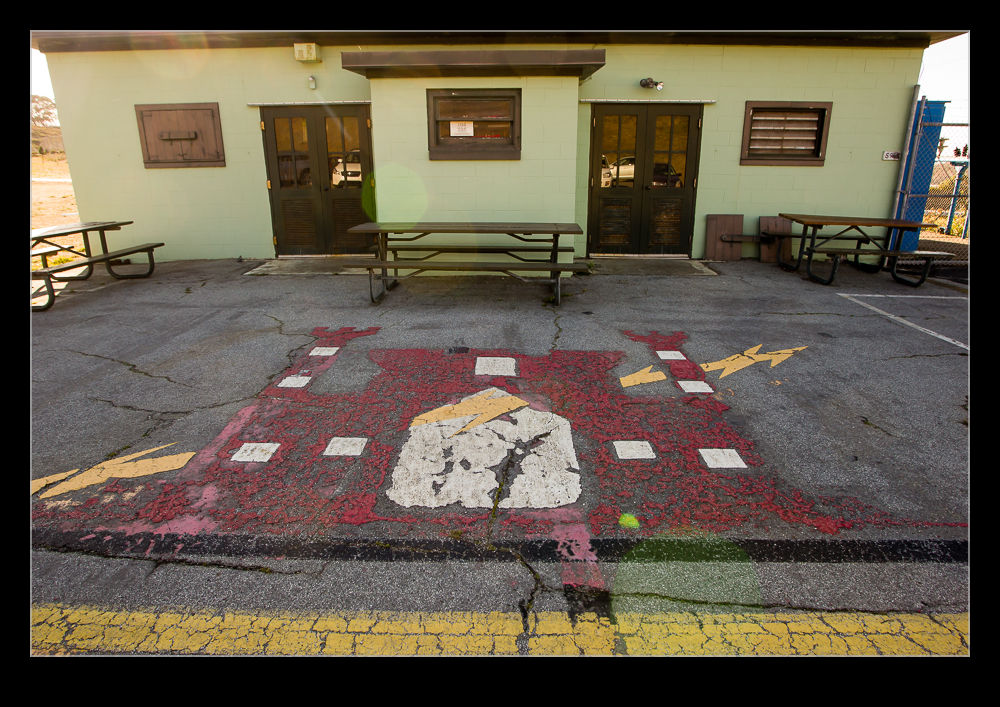 The only relatively intact location is just outside San Francisco on the Marin Headlands. Located in a National Park, SF-88 opens to the public most Saturdays. The last of over a dozen installations in the San Francisco area, it has preserved the core infrastructure of the installation even if it is condensed into a smaller area that was the case when it was operational. The facility has a search radar and a tracking radar on display. The search radar was used to identify the targets initially. Then two tracking radar were used to carry out the attack.
The only relatively intact location is just outside San Francisco on the Marin Headlands. Located in a National Park, SF-88 opens to the public most Saturdays. The last of over a dozen installations in the San Francisco area, it has preserved the core infrastructure of the installation even if it is condensed into a smaller area that was the case when it was operational. The facility has a search radar and a tracking radar on display. The search radar was used to identify the targets initially. Then two tracking radar were used to carry out the attack.
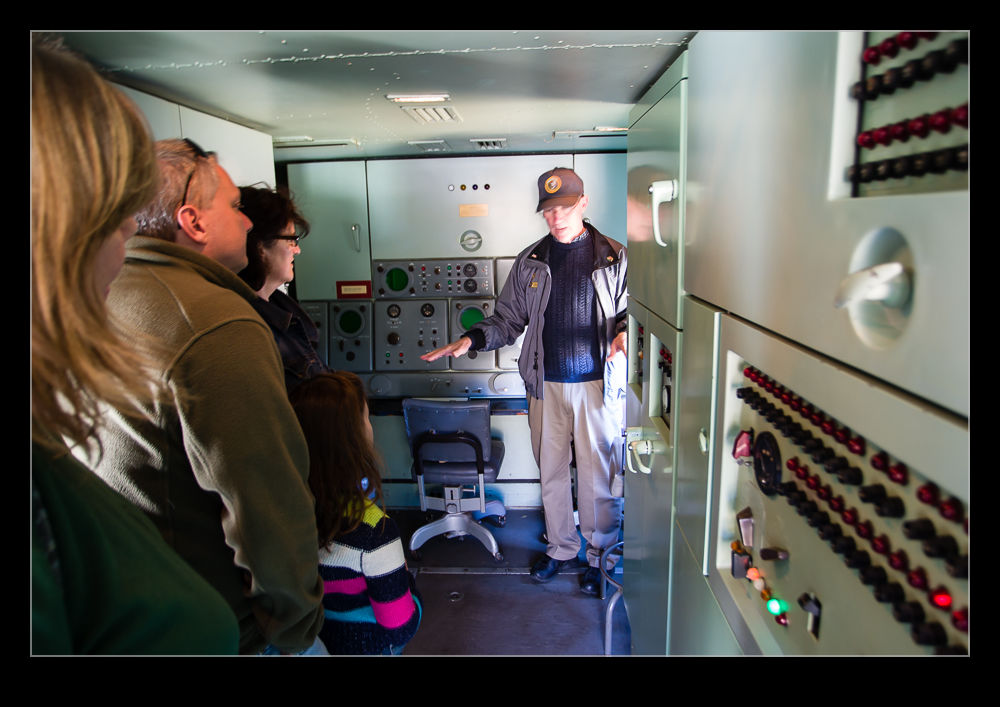 The first tracking radar would lock on to the target. The second would track the missile as it was outbound. The missile did not guide itself. It received command guidance from the ground. The two tracking radar would feed data to the analog computers that controlled the system. It would then determine the guidance parameters to be transmitted to the missile. The missile had four antennae on board – two to receive and two to transmit. It would then make course corrections based on the signals received. It would initially boost to very high altitude before arcing over and homing in on the target. The aim was to detonate just ahead of the target to either provide a cloud of fragments into which it would fly or, in the case of the nuclear warheads, to obliterate it. Even if the nuclear warhead detonated too far away to disable the aircraft, the electromagnetic pulse was considered likely to render the weapons inoperative.
The first tracking radar would lock on to the target. The second would track the missile as it was outbound. The missile did not guide itself. It received command guidance from the ground. The two tracking radar would feed data to the analog computers that controlled the system. It would then determine the guidance parameters to be transmitted to the missile. The missile had four antennae on board – two to receive and two to transmit. It would then make course corrections based on the signals received. It would initially boost to very high altitude before arcing over and homing in on the target. The aim was to detonate just ahead of the target to either provide a cloud of fragments into which it would fly or, in the case of the nuclear warheads, to obliterate it. Even if the nuclear warhead detonated too far away to disable the aircraft, the electromagnetic pulse was considered likely to render the weapons inoperative.
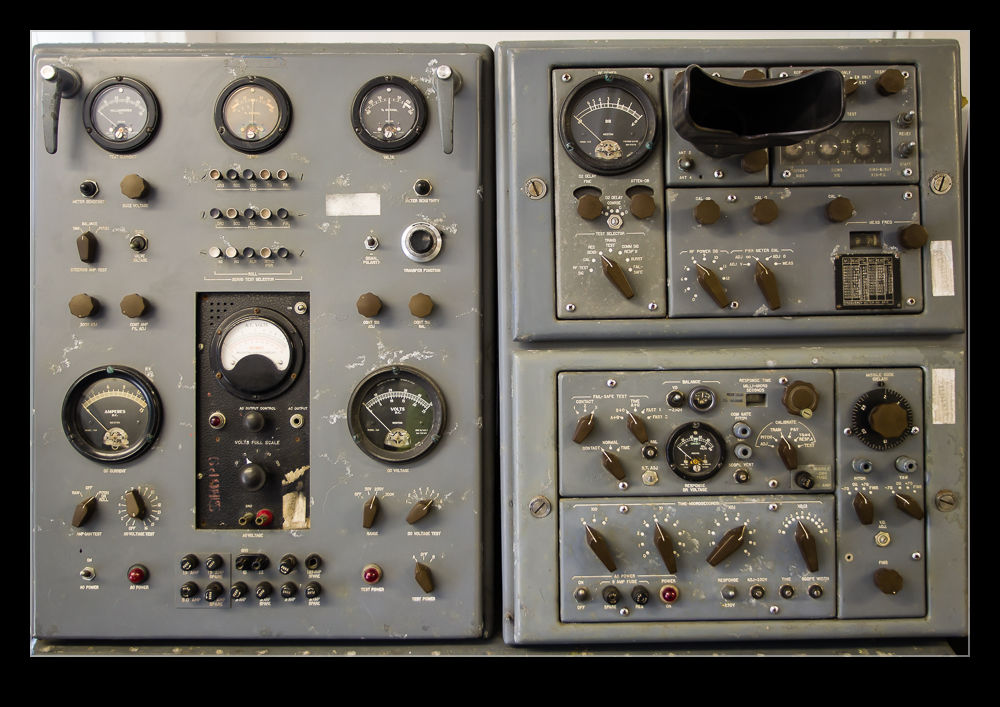 The control systems are on display in metal cabins above ground. These systems were considered mobile if required, hence them not being buried. The same was not the case for the missile bunkers. They are underground with hatches to the surface through which the missiles would be raised and lifted into the near vertical launch position. These facilities are still in place and the tour includes the chance to go underground, see a selection of Hercules missiles on the launch racks including one that is ready to lift. When the guide has finished providing an explanation of the missiles and their usage, a climb back up out of the bunker allows you to see the missile being raised up out of the ground and into its launch position.
The control systems are on display in metal cabins above ground. These systems were considered mobile if required, hence them not being buried. The same was not the case for the missile bunkers. They are underground with hatches to the surface through which the missiles would be raised and lifted into the near vertical launch position. These facilities are still in place and the tour includes the chance to go underground, see a selection of Hercules missiles on the launch racks including one that is ready to lift. When the guide has finished providing an explanation of the missiles and their usage, a climb back up out of the bunker allows you to see the missile being raised up out of the ground and into its launch position.
Only one missile could be fired at a time since the control system could only manage the tracking of one missile. However, four launchers were part of the battery so multiple engagements could take place and batteries elsewhere in the area could also engage. Once the missile had finished its flight, another could be loaded to go. However, the large booster did leave its mark. While it was scheduled to be jettisoned shortly after launch and to fall out to see, the intense heat could set fire to surrounding debris and the guides also talk about some falling propellant still burning as it came down. Not a good place to be. The sound of launch was also intense, even when in protected environments.
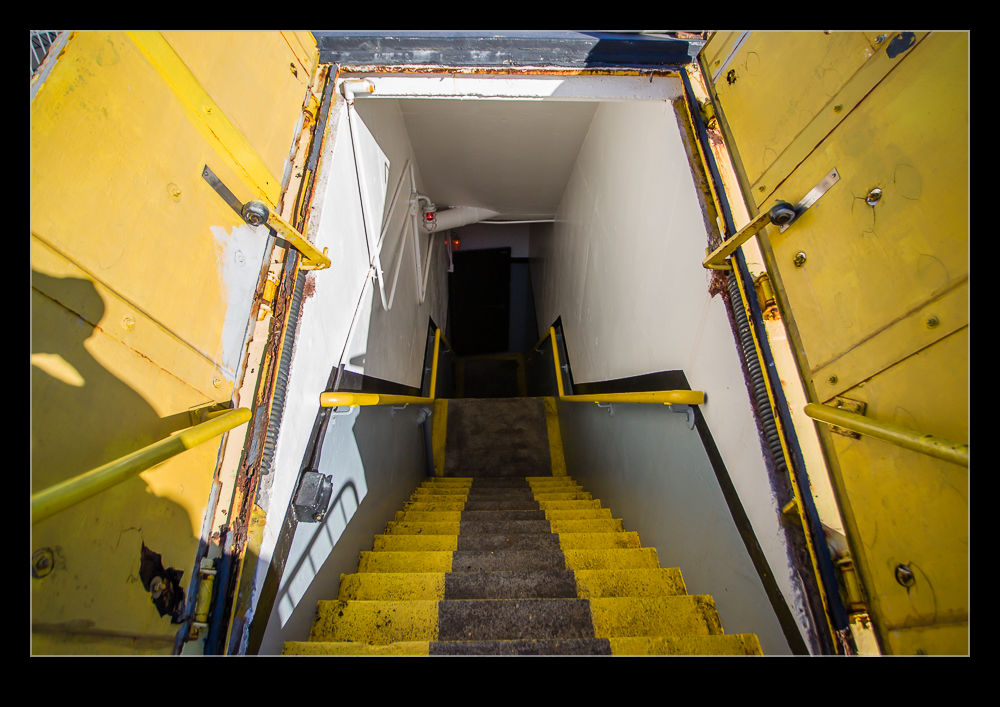 No launches ever took place within the United States of deployed missiles. However, regular launches were undertaken by crews for training. These were carried out at White Sands Missile Range with the crews deploying there periodically to practice actually firing the missile. These missiles obviously did not have the nuclear warheads but were aimed at incoming target drones, some examples of which are also part of the installation.
No launches ever took place within the United States of deployed missiles. However, regular launches were undertaken by crews for training. These were carried out at White Sands Missile Range with the crews deploying there periodically to practice actually firing the missile. These missiles obviously did not have the nuclear warheads but were aimed at incoming target drones, some examples of which are also part of the installation.
The Marin Headlands are full of military installations long retired. Gun batteries designed to protect the Bay Area from naval assault are common. However, the Nike Installation SF-88 is a unique example of some more modern weaponry that was located all around San Francisco with most people being totally unaware it was there. A visit to see this amazing place is well worthwhile if you are in the area.

